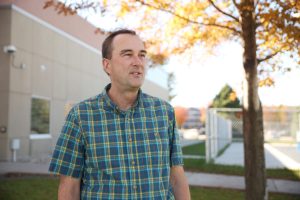
From left, Rapid City Mayor Jason Salamun, Sioux Falls Mayor Paul TenHaken and South Dakota Attorney General Marty Jackley appear at a press conference on Aug. 20, 2025, in Sioux Falls. (John Hult/South Dakota Searchlight)
South Dakota’s state lawyer picked a fight this week with the Department of Social Services over the agency’s handling of a $79 million pool of opioid settlement money.
Attorney General Marty Jackley wants the bulk of the dollars to land in Sioux Falls and Rapid City for addiction treatment, and says he’ll ask lawmakers to disband the state’s opioid settlement oversight committee if its members disagree.
But the Department of Social Services — the agency designated as the settlement money manager by the Legislature — says neither city has applied for opioid grant money, and the current pool of available funding isn’t as large as Jackley asserts.
The department also said Jackley did not reach out about his concerns before holding a press conference on the topic Wednesday in Sioux Falls.
Jackley spoke to reporters that day from a lectern at Sioux Falls City Hall, flanked by Sioux Falls Mayor Paul TenHaken and Rapid City Mayor Jason Salamun.
SD uses portion of opioid settlement funds to distribute overdose prevention kits
The opioid money, split 70% for the state and 30% for local governments, will arrive in chunks over the next 18 years. It comes from a series of nationwide settlements with the makers and sellers of the opioid painkillers that contributed to a spike in drug addiction and overdoses.
The state has collected $31.5 million of its share of the settlement dollars since 2022, Jackley said Wednesday, and he asserted that state government has spent almost none of its share.
That’s not accurate, according to Department of Social Services Secretary Matt Althoff. The $31.5 million figure is the total amount received since 2022. What’s left right now is about $17 million, because $14 million has been spent or obligated.
The Sioux Falls and Rapid City areas have both gotten a significant chunk of the money, the statement said. That’s because 30% of the dollars are distributed directly to local governments, which are then required to tell the DSS, on an annual basis, how the money is spent.
Last year alone, the statement read, the cities of Sioux Falls and Rapid City and the counties of Minnehaha, Lincoln and Pennington got a combined $3.9 million in opioid settlement money.
“As of Dec. 31, 2024, over $3 million of those funds were reported to the state as unspent,” Althoff’s statement said.
Cities and counties will need to report how they’ve used their local shares for 2025 by Jan. 31, 2026.
Local governments can also ask for additional money by requesting grants, paid for from the state’s 70% share, Althoff said. Sioux Falls and Rapid haven’t asked for extra.
Jackley: Spend the money now
Jackley argued Wednesday, however, that the two major cities would be best suited to decide where the money goes.
Using the money to bolster existing addiction treatment options, Jackley said, “presents that opportunity for us to be able to get ahead of the problem, to address the crisis” of drug addiction.

The settlement money is received and managed by the Department of Social Services, but its uses are overseen by the state’s Opioid Advisory Committee.
The advisory committee’s public plan for settlement dollars puts a large portion of the money into an interest-bearing account for distribution as grants. That’s the wrong approach, Jackley told reporters this week.
It could also cause the state to lose 15% of the settlement dollars, he told reporters in Sioux Falls, because the settlement agreement dings states that place money in an endowment.
“Why would we want to lose 15% of $79 million?” said Jackley, who later told Sioux Falls Live’s Patrick Lalley that he’d be concerned that lawmakers would raid the fund for purposes beyond opioid programming, such as property tax relief.
The national settlement specifies that no more than 15% of any states’ dollars can be spent on administration of the funds, and that 85% must go to opioid-related programs.
The Department of Social Services, in its statement, maintains that the state has not used the dollars for an endowment that would pay for things outside of opioid crisis mitigation.
The law that created South Dakota’s fund for opioid dollars says the money can “only be used for purposes relating to opioid abuse treatment, prevention, and recovery programs.”
On Thursday, Jackley said he’d spoken with DSS officials about the fund, who allayed his concerns.
“I commend DSS’s commitment to not place the funds into an endowment, which is a disfavored use under the settlements,” Jackley said.
Even so, his Thursday statement doubled down on criticisms of the speed of disbursements from the state’s share of settlement money.
“In the three years since DSS has administered the fund, it has reported expending only $634,000 of state funds on opioid remediation, and we must act now to address the addiction crises of today,” Jackley said in a follow-up statement Thursday, citing the 2024 annual report on the fund.
The DSS did not offer a detailed breakdown of its own opioid fund spending, but spokeswoman Emily Richardt said Thursday that the department has distributed around $1.6 million so far, all in grants to local organizations. The $634,000 figure Jackley cited from the last annual report is short 15 months of spending. The next annual report is expected to be released within the next few months.
A statewide needs assessment, set to be completed by next spring, is meant to guide state-level spending beyond the local grant awards.
YOU MAKE OUR WORK POSSIBLE.
Mayors: Needs are great
Avera’s juvenile treatment center is one example of the kind of treatment infrastructure that needs help in Sioux Falls, Mayor Paul TenHaken said at the press conference. It has eight beds and “they’ve been full since they opened,” he said, citing a conversation he had with health system representatives on Tuesday.
“The need there is great,” said TenHaken.
He also pointed to the city’s mental health and addiction triage partnership with the county and health systems known as The Link.
“It takes several million dollars every year from the city and the county and our health care systems to run, and so dollars are needed,” TenHaken said.
State committee plans needs assessment for remainder of $54 million in opioid settlement funds
The Department of Social Services, in a statement sent Thursday, noted that a total of $825,569 in the Sioux Falls area’s local share of opioid money had been reported as dedicated to the Link through 2024.
In response, TenHaken said Thursday that the city intends to spend its remaining local allocation of opioid funds for The Link.
“Based on guideline interpretations on how funding can be spent, the city plans to have all anticipated balances spent by 2036, which is intended to support The Link’s Opioid Response Program,” the statement said.
The mayor’s statement did not address the question of a lack of grant requests from Sioux Falls for shares of the state’s allotment of opioid dollars.
TenHaken’s Rapid City counterpart referenced operations similar to The Link in the West River population center during Wednesday’s press conference. Mayor Salamun said addiction often fuels crime, and that it tears up families and communities even when it doesn’t.
“So many of us know people who battle with addiction to whatever it may be, and we know it destroys lives,” Salamun said, pointing to his own family’s experiences. “It is the true enemy.”
Salamun, in a Thursday statement, did not address his Rapid City’s unspent funds.
“The question is not whether some of the opioid settlement dollars have been distributed, but how we can use them more effectively,” the statement read. “We commend the state’s efforts so far and believe that allocating these funds more strategically toward effective treatment and rehabilitation could have a greater impact.”
Jackley said he wants to offer treatment “before people are convicted of a drug felony,” and said that allowing the mayors to make connections can make that happen quickly.
He also said he’s willing to work with the opioid committee on the plan, but that he’s ready to ask lawmakers to dissolve it if the group continues to bank settlement dollars instead of spend them.
Jackley: Committee framework unfortunate
South Dakota first signed on to the opioid litigation during Jackley’s first term in office, which began in 2009. He left the post in 2019, after a loss to Kristi Noem in the 2018 GOP gubernatorial primary. By the time he’d returned to the Attorney General’s Office, in 2023, lawmakers had designated the Department of Social Services as the opioid money administrator and passed legislation creating the advisory committee.
On Wednesday, Jackley said he’d have fought to maintain control of the money, had he been in charge at the time. The office of former Attorney General Jason Ravnsborg supported the 2022 bill that put the dollars in the care of the department and committee.
Even as Jackley said the money should’ve been managed by the attorney general, he said he understood why lawmakers created an oversight committee.
“When you’re talking north of $79 million, perhaps it makes sense that there’s additional oversight over the attorney general,” he said. “ I’m respectful of that, but I’m passionate that these dollars need to get to use now.”
DSS: Press conference misleading, inaccurate
Althoff’s statements, sent on Wednesday evening and Thursday afternoon, contradicted Jackley. Beyond saying that money had been allocated to local governments, it said the attorney general had misstated the amount of money the state has received so far.
The proposal from Jackley for a Sioux Falls and Rapid City opioid money disbursement “appears to be for $31 million from a fund that has $17 million,” Althoff’s statement said.
He said the money already spent using the funds, for efforts like a $350,000 investment in 20,000 overdose-reversal kits and overdose follow-up programming, is making a difference.
“South Dakota continues its trend of low rates of opioid prescriptions and the lowest rate of deaths by opioid overdose due, in part, to this comprehensive work,” the statement said.
Althoff said his department “stands ready” to work with any local government that needs help battling opioid addiction.
“If these particular elected officials are interested in working with DSS on this issue, it would be more effective to reach out to us, rather than calling a press conference without ever having done so,” it says.
GET THE MORNING HEADLINES.





